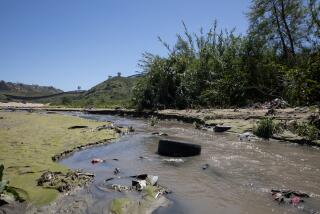Irvine Approves Landmark Study to Gauge Health Effects of Toxins : Pollution: Council responds to news report showing the city among most affected by airborne emissions from manufacturers.
IRVINE — Faced with some of the highest levels of toxic pollutants recorded in the county, the City Council has approved a groundbreaking study to assess the health effects of hazardous chemicals spewed into the air by hundreds of high-tech manufacturers.
Council members voted 4-0, with one member absent, late Tuesday night to undertake what is believed to be the first research by a city in the United States to determine health risks from toxic chemicals.
“We know there are cancer-causing elements being spewed into the air, but what does that mean? I don’t know,” said Councilwoman Paula Werner, who proposed the study. “I would be happy as a lark if they came back and said, ‘Yes, we are spewing some cancer-causing chemicals, but it doesn’t have an impact.’ ”
Werner said her proposal was prompted by an April 23 story in The Times detailing the release of toxic pollutants by manufacturing plants in several Orange County cities. The article indicated that Irvine manufacturers generate among the highest levels of toxic chemical emissions in the county.
According to data compiled by the federal Environmental Protection Agency, some 500 Irvine-based companies reported emitting more than 2 million pounds of toxic pollutants in 1988--the second-largest emission level in the county that year.
Michael S. Brown, Irvine’s environmental program administrator, said that the amount dropped to 1.4 million pounds in 1989, largely as a result of a local program to reduce industrial emissions of chlorofluorocarbons, an ozone-depleting chemical.
Among the toxic substances released into the air over Irvine are such known carcinogens as sodium hydroxide and ethylene oxide. Other hazardous pollutants include ammonia, dichloromethane and acetone.
Although all of the companies in Irvine met legal standards for toxic emissions, city officials said they remain concerned about the cumulative effects of airborne toxins.
“The emissions from one source might not be a problem,” Brown said, “but what if you have 10 or 15 emitters in an area all doing the same amount? We have not been looking at the aggregate.”
Although the industrial and vehicle pollutants that cause smog are heavily regulated and monitored, Brown said, there are relatively few controls on many toxic chemicals released by manufacturers.
For the study, the city will gather pollution data from federal, state and regional agencies on the types and amounts of toxic chemicals released in and around Irvine. The information will be used to make a model of emission patterns over the city and to estimate the potential exposure.
The pollution levels will then be collated with existing medical research to assess health risks.
Brown noted that the study could run into several pitfalls. The type of research is so new there are no proven methods to rely on, he said, and the city’s scientific advisory committee, a group of volunteers, does not yet have any members well-versed in toxic chemical emissions, except for chlorofluorocarbons. Also, the city has not earmarked any funds for the research.
Brown said he hopes to recruit academic scientists and others with expertise in air pollution who will volunteer their time for the eight-month study.
In addition to the study, Irvine has led the nation with two similar efforts--an ordinance to reduce chlorofluorocarbons and a law requiring industries to report their use of hazardous materials to the city. Both programs have been copied by other cities across the country.
“Irvine has usually been at the lead in developing new environmental initiatives. To my knowledge, no one yet is doing an aggregate assessment,” said Tom Eichhorn, a spokesman for the South Coast Air Quality Management District. “I would think, however, that others will be looking at similar aggregate analyses once these (Irvine’s) reports are in.”
Times correspondent Tom McQueeney contributed to this report.
More to Read
Sign up for Essential California
The most important California stories and recommendations in your inbox every morning.
You may occasionally receive promotional content from the Los Angeles Times.










